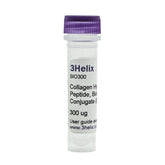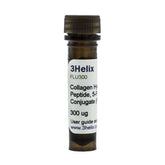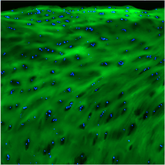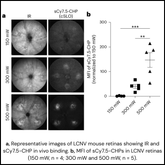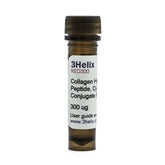Collagen Hybridizing Peptide Detects Excess Collagen Degradation in Periodontal Ehlers-Danlos Syndrome Fibroblasts
Ehlers-Danlos syndrome (EDS) is a cluster of connective tissue disorders with a range of manifestations across organ systems. Periodontal EDS (pEDS) is a form of EDS characterized by weakening tissue around the teeth, leading to fragile gums, gingival recession, and tooth loss. pEDS has been linked to heterozygous missense mutations in the genes for C1r and C1s proteins, which are part of the complement pathway of the innate immune system. pEDS thus differs from other EDS types, which usually arise from mutations in ECM proteins themselves - as opposed to immune system proteins. The link between mutated immune proteins and a connective tissue disorder has not been made until now, when these researchers studied the collagen-digesting function of C1s.
As part of the initiation of the classic pathway of complement activation, two C1r and two C1s proteins form a heterotetramer and bind to C1q, triggering the complement cascade. C1q contains collagen-like domains that serve as binding sites for the C1s/C1r complex. These domains are proteolytic targets, the cleavage of which drives C1q activation and subsequent complement activation. In healthy patients, C1s is only proteolytically active when in the heterotrimer complex. In pEDS, though, mutations in C1s enable constitutive activation and unrestricted collagen degradation, interfering with the fine balance of ECM remodeling. Excess collagen digestion leads to ECM structure and causes tissue fragility, a hallmark of the pEDS phenotype.
Read More About the Study's Findings
Researchers were able to demonstrate enhanced proteolytic activity of mutated C1s in vitro using dermal fibroblasts taken from pEDS patients. Patient cells were grown in parallel with cells from healthy patients for 7 days on a coverslip, which was subsequently washed and stained for collagen deposition with anti-Col I antibody and for collagen damage with F-CHP. They observed low antibody staining in the diseased cells, indicating decreased deposition of type I collagen. F-CHP staining, on the other hand, was greatly enhanced in the diseased group, indicating significant ECM damage. CHPs hybridize specifically to non triple-helical (denatured) collagen, which is present when a collagen-digesting enzyme is applied at physiological temperature. The enzyme, C1s in this instance, will cleave one of the chains of the triple helix, which then unwinds and separates into individual chains at 37 °C. This cleaving and unwinding is the basis for collagen turnover, which is the process by which ECM collagen is replaced. However, excess proteolytic enzymes will improperly accelerate turnover, resulting in weak and disorganized ECM.

Fig. 1. Assessing collagen deposition and structure in dermal fibroblast culture. Control Groups: Co1, Co2, & Co3. Disease Groups: p.V50D, p.G93C, & pR301P. The red stain indicates intact collagen type I, which is more prevalent in the healthy control groups. The green stain indicates damaged collagen at the triple-helical level, which is more prevalent in the disease group.
In conclusion, this study has provided the first direct evidence linking mutated C1s, a component of the innate immune system, to the excessive collagen I degradation seen in periodontal Ehlers-Danlos Syndrome. Utilizing the unique ability of Collagen Hybridizing Peptides to specifically bind and visualize denatured collagen, researchers were able to demonstrate a significant increase in collagen damage in pEDS fibroblasts compared to healthy controls. This highlights the powerful utility of CHPs as molecular probes for assessing collagen integrity and degradation.
Looking forward, this successful application of CHPs in revealing pEDS pathology opens up the potential utility of CHPs as valuable tools for other areas of characterization for pEDS. For example, diagnostics, disease progression monitoring, and informing the development of targeted therapeutics. Creative application of CHPs, could help to further understand and eventually preserve the delicate balance of ECM remodeling in EDS and other connective tissue disorders.
FULL PAPER:
|
Amberger, Albert, et al. "Degradation of collagen I by activated C1s in periodontal Ehlers-Danlos Syndrome." Frontiers in Immunology 14 (2023): 1157421.
|
|
